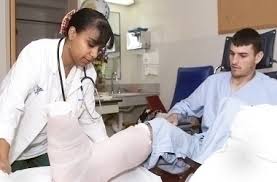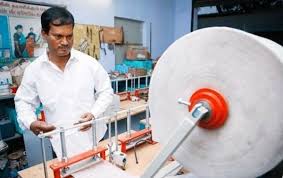
The ways stigma can influence health care delivery for marginalised people and groups in Australian society
Order Instructions:
Discuss the ways stigma can influence health care delivery for marginalised people and groups in Australian society? People from the following groups may be stigmatized.
Explore this question from one of the following marginalised groups: refugees, Indigenous Australians, mentally ill or homeless people, older adults or the disabled.
Students will learn to reflect on sociological topics related to society, culture and health and apply the Sociological Imagination Template to their chosen topic. Using the Reflective Learning and Writing Proforma on LEO respond to one of the two topics provided below for the reflective assessment task. Use the proforma steps as headings and write in paragraphs below the headings. Ensure that you use all the factors from the SI template in completing this reflective writing task. It is not necessary to use all four factors in every Step of the proforma. All sources should be referenced using APA style.
SAMPLE ANSWER
The ways stigma can influence health care delivery
Step 1:
Carefully choose one question from the Reflective Learning and Writing Assessment section of the unit outline to guide your reflection. Write the question here:
How does stigma prevent the delivery of healthcare to mentally ill patients in Australia?
Step 2:
Reflect upon and analyse your experiences and observations in relation to your chosen question from Step 1, using the four factors from Willis’ (2004, as cited in Germov, 2014, p. 7-8) sociological imagination template (SI template):
Whereas the treatment of mental illness in Australia is embedded on technological advances and medical research that is informed by not only scientific inquiry but also evidence based results, stigma tends to impact the quality of care patients receive. While dealing with mentally ill patients at my former place of work, I would notice stigma as the most terrifying barrier to quality mental healthcare. One of my patients, who traced her roots in South Asia, recounted just cultural issues impede members of this community from seeking mental healthcare owing to negative thoughts and ethos that encourage the community to pinpoint persons with mental illness. Moreover, an aboriginal patient with a poor self-mage indicated that members of his community tend to repress symptoms to an extent that they fear seeking medical attention after internalizing the community mindset. By and large, this is evident of cultural stigma, which is anything but a cultural mindset unconsciously perpetuated by members of the community Willis’ (2010, as cited in Germov, 2014). Additionally, stigma hinders their access to services and contributes to low self-worth and greater seclusion and despair. A shocking revelation of how stigma impacts on the delivery of healthcare was evident when mentally ill patient indicated how medical practitioners would treat them as non-entities. As a team leader, I made a follow to determine if the allegations were founded or malicious. Going through the patient’s medical record I was able to identify the care giver that had attended to the patient. After a close examination I noticed that both the caregiver and the patient shared the same cultural background. With this revelation I was quick to learn that caregivers with a certain cultural orientation irrespective of their medical background tend to hold with high esteem issues of stigma and the society’s mindset. This is demonstrated by the highest level of discrimination against persons with mental illness when it comes to the delivery of quality healthcare Willis’ (2010, as cited in Germov, 2014).
With this backdrop from a clinical setting, I learnt that a genuine interaction from the community through to medical facilities in the absence of a pre-determined mindset can help curtail stigma. Essentially, these experiences demonstrate that minority groups have similar views concerning the stigma that persons with mental illness are subjected to wherever they go (Bradby, 2012). An elder brother to one of my patients’ told me just how stigma had crushed the self-esteem of not only the patient but also the entire family on allegations that that could imply a family spell that sweeps across blood of generations. It becomes common sense that stigmatization is literally what hinders the minority group from seeking medical attention (Hampton and Toombs, 2013).
Step 3:
Next, identify and cite one of the readings, articles or videos from eModule 1 or 2 and discuss how this resource helps you to expand and deepen your original reflections on this topic. Remember to relate the information from this resource back to the factors from the sociological imagination template. (400 words; use two academic sources – one from your textbook Second Opinion by Germov (2014))
The article’s commitment in highlighting stigma as a deterrent to quality mental health care helped me to understand the need for advocacy to de-stigmatize the people. In addition, I learnt new discoveries, techniques and knowledge synthesis. Past studies have main concentrated on descriptive, for instance number of individual that stigmatize depression. The articles adequately evaluate theoretical approaches of stigma. Furthermore, I learnt how stigma operates from a social perspective because the author would conceptualize stigma as a series of mind set and stereotypes about groups. For instance, the mental ill have been considered by the society to be dangerous which is not the case (Germov, 2014). Besides, I learnt that sociologists consider stigma as a structural aspect. This is based on the political as well as economic reasons, particular institutions have been set in the society which promote stigma or lead to discrimination of people with mental illness. For example, for mental illness one of the structural forms is the law which undermines their ability to vote, have a family among others. The article also exposed the fact that people with psychiatric problems do not get the medical attention compared to other people. This implies that medical facilities discriminate against people with mental illness. Another thing would emerge from the article is the labeling theory. The term stigma would suggest that mental ill persons are socially unkempt. So the article helped me to understand that just because someone has to check with psychiatrist does not mean that they are mentally ill (Germov, 2014). The article demonstrates that stigmatization many interfere with treatment. These are some people with mental illness that decide not to seek for medical attention. So the article enabled me to understand that persons with mental illness want to avoid the labels by refusing to seek psychiatrist attention.
According to the article, I learnt that there different ways of combating stigma including public awareness, protest and contact. Protest is like shame on you type of statement and an appeal to the public to change their negative mindset towards people with mental illness. On the other hand, public awareness is all about transposing the myths of mental illness using facts. Much as public awareness is widely used, its impact seems to wash out in short period of time. Contact approach is involved with introducing persons with psychiatric illness to rest which decreases stigma. Much as the article exposes that structural stigma can be combated in accordance with social justice, I learnt that it has some associated implications. For instance, its injustice to leave mental issues to people with this problem, rather this is a society’s challenge which requires looking at changes in the community to provide these people with an equal chance.
Step 4:
Now, building upon your reflections using the sociological imagination template, answer the original question you identified in Step 1, using at least four academic sources (e.g. journal articles, research reports) to support your answer. Locate these academic sources through your own information search.
Stigma and discrimination continue manifesting as a part of the fabric and tradition of Australia society (Burbank, 2011). It has significantly affected minority populations, the general healthcare system, and the nursing profession. Usually, stigma is based on the differences that arise due to age, ethnicity, religion, sexual orientation, gender, race, age or any other characteristic by which people vary (Massaro, 2012). The Australian Nursing Association is determined to work towards the eradication of stigma and discrimination in the profession of nursing, in the education of nurses, in organizations where nurses work as well as well as in the practice of nursing (Barry & Yuill, 2012).
The organization is also committed to promoting egalitarianism and promoting justice in the access and delivery of quality health care to all people regardless of their differences. Stigma associated with mental illness has been attributed to unfairness when it comes to unequal treatment of persons suffering from the condition (Willis, Reynolds & Keleher, 2012). Stigma leads to individual prejudice in terms of disallowed resources, and systemic inequity such as socio-economic, legal and institution discrimination. Moreover, stigma often thwart mentally impaired persons from seeking medical attention, sticking to treatment procedures, getting employment and living harmoniously in the society.
Mindsets towards mental infirmity differ among persons, households, traditions, cultures and nations. Cultural as well as religious teachings impact beliefs concerning the origins and nature of mental sickness (Willis, Reynolds & Keleher, 2012). Besides influencing whether persons with mental illness face social embarrassment, perceptions about mental sickness can impact patients’ eagerness and motivation to look for medical treatment and stick by the guidelines. Deeply ingrained stigmatization has had a wide range of implications in Australia. Structures of discrimination continue putting a severe toll on the minorities contributing majorly to the fact that the minorities are still dying at a younger age compared to other people in the general population (Keleher & MacDougall, 2011). Here are some of the ways through which stigmatization affects health care delivery.
As such, comprehending both cultural and individual mindset about mental sickness is elementary for the execution of proficient strategies to mental health care. Studies indicate that individual experience with mental sickness is distinct. An assessment of ethno cultural value system and mental sickness conducted by Willis & Elmer, (2011) underscores a broad range of cultural beliefs concerning mental health. For example, whereas American Indian communities do not confound mental sickness, others castigate only some mental sickness, while others castigate all mental sickness.
Stigmatization puts the marginalized groups at great risk for long-term health problems. For instance, previous research has found out that refugees who are exposed to stigmatization especially during adolescence have high chances of developing stress-related health issues (Massaro, 2012). This puts them at the risk of acquiring chronic diseases later in their life. Researchers found out specifically that this group of individuals is more likely to have higher levels of hypertension, higher levels of stress related hormones once they turn 20 and a higher body mass index (Barry & Yuill, 2012). Stigmatization also exposes minority groups to high psychological toll which has been linked closely to hypertension. Just the fear of discrimination triggers stress-related responses among refugees which translate to the constant biological stressors that these individuals experience.
Nonetheless, the castigation of mental sickness can be controlled by other variables including perceived cause of the sickness. A study conducted in 2003 on Chinese Americans and European Americans were executed with a vignette in which persons with schizophrenia were diagnosed (LaNave & Navarro, 2013). Respondents were informed of the fact that individual’s sickness was somewhat hereditary in origin, as such respondents were queried to contemplate a scenario in which their children would date, marry or replicate with the subject of the vignette.
In Australia, majority of nurses harbor unconscious racial biases especially towards marginalized groups especially the Indigenous Australians. A study conducted in 2012 indicated that about two-thirds of primary care nurses discriminate against the Indigenous Australians. The research suggested that clinicians spend less time with the Natives and do not involve them in medical decisions. However, majority of the health officials are not aware that they are treating this group of people any differently (Bessant, & Watts, 2012).
Genetic ascription of mental sickness importantly abridged the reluctance to get married and procreate among Chinese Americans, while enhancing the same among the European Americans, a factor that underpinned previous findings of cultural differences. Genetic attribution of mental illness significantly reduced unwillingness to marry and reproduce among Chinese Americans, but it increased the same measures among European Americans, supporting previous findings of cultural variations in patterns of mental illness stigmatization (Bessant & Watts, 2012). This form of stigma creates an environment in which the Natives do not feel welcome in the medical system that some have started to avoid seeking medical attention. This has led to the deterioration of their health and increased number of deaths among this group. Furthermore, Indigenous Australians are more likely to lack access to health insurance and less likely to have a regular doctor for checkups. This has resulted in circumstance whereby the Natives die from preventable diseases at higher rates compared to other people in the society due to delayed treatment (Couzos & Murray, 2010).
Several studies have demonstrated other considerable attitude variations towards mental sickness among various cultures in North America. For instance a comprehensive observation ethnographic research of chronic mental ailing people, the European respondents regularly seek treatment from health care providers and seem to convey beliefs regarding mental conditions related to biomedical views on the sickness (Macionis & Plummer, 2012). On the other hand, African Americans as well as Latino respondents mostly put emphasis on non-biomedical understanding of the symptoms of mental sickness. Even though participants alleged that they face stigma as a result of their mental condition, stigma was the main aspect of African Americans’ views however it was not greatly accentuated by European of American decent (Couzos & Murray, 2010).
Step 5:
Finally, choose one of the Graduate Attributes (at the front of the Unit Outline) that is most relevant and explain how answering this eModule question has helped you to develop this Graduate Attribute.
Research and Inquiry:
The answering of this eModule has helped me to enhance my research and inquiry skills. In bid to understanding how stigma impedes healthcare especially on person with mental health, I conducted an extensive study that highlights the popular belief on persons that need mental healthcare. The review of literature from various sources gave me not only an informed position from which to argue my case, but also augmented my knowledge base in nursing. The discrimination perpetuated by healthcare facilities against persons with mental illness shaped not only my critical thinking skills in try to formulate new comprehension but also when it comes to appraising the existing body of literature on nursing and to acknowledge the drawbacks of that knowledge. Having noted that most studies had been devoted in exploring the public view of mental illness, I would therefore recommend research on community based mitigation plans or approaches through proper legislation as the best way to controlling the segregation that persons with mental illness grapple with. In the end, I have come to realize the importance of research and management care.
References
Barry, A-M., & Yuill, C. (2012). Understanding the sociology of health: An introduction (3rd ed.). London: Sage.
Bessant, J., & Watts, R. (2012). Sociology Australia (3rd ed.). Crow’s Nest, NSW: Allen Unwin.
Bradby, H. (2012). Medicine, health and society: A critical sociology. Thousand Oaks, CA:Sage.
Burbank, V. K. (2011). An ethnography of stress: The social determinants of health in Aboriginal
Couzos, S., & Murray, R. (2010). Aboriginal primary health care: An evidence-based approach (3rd ed.). South Melbourne, VIC: Oxford University Press.
Germov, J. (2014). Second Opinion: An Introduction to Health Sociology. Fifth Edition. Oxford University Press.
Hampton and Toombs (2013) Indigenous Australians and health: The wombat in the room. South Melbourne, VIC: Oxford University Press.
Keleher, H., & MacDougall, C. (Eds.). (2011). Understanding health: A determinants approach. (3rd ed.). South Melbourne, VIC.: Oxford University Press.
LaNave, K., & Navarro, C.S. (2008). Teaching manual for living justice and peace: Catholic social teaching in practice. Winona, MN: Saint Mary’s Press.
Macionis, J.J., & Plummer, K. (2012). Sociology: A global introduction (5th ed.). Harlow, UK: Pearson/Prentice Hall
Massaro, T. (2012). Living justice: Catholic social teaching in action (2nd Classroom ed.). Lanham, MD: Rowman & Littlefield.
Willis, E., Reynolds, L., & Keleher, H. (Eds.). (2012). Understanding the Australian health care system (2 nd ed.) Chatswood, NSW: Elsevier.
Willis, K., & Elmer, S. (2011). Society, culture and health: An introduction to sociology for nurses. (2nd ed.). South Melbourne, VIC.: Oxford University Press.
We can write this or a similar paper for you! Simply fill the order form!












